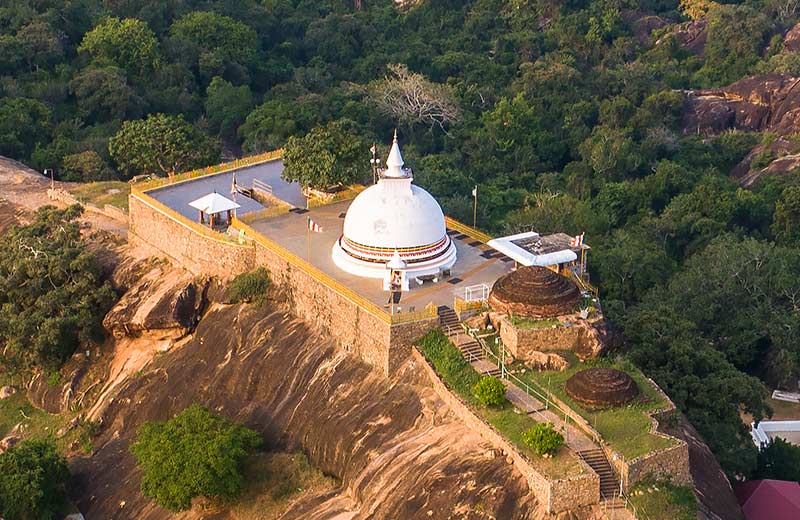Sithulpawwa Rajamaha Viharaya
Situated in Kirinda in Hambanthota District, Sithulpawwa Rajamaha Viharaya has also being called Chiththala Pabbatha in the ancient texts. Stone Inscriptions has identified this location as “Chithala Paawatha Vehera”. This temple complex is attributed to King Kavanthissa who ruled southern area of the country.
Sithulpawwa is known as a location where thousands of Arhaths lived at one time. According to folklore it is said that a novice monk called Thissa who has reached the state of Arhath lived here and later a stupa was built encasing his remains thus this also has been known as Tissa Thera Chetiya.
Sithulpawwa Rajamaha Viharaya contains large number of stupas, cave temples, Buddha statues a stupa house and image houses spread among a large land area. Among these there is a cave temple with ancient paintings thought to be belonging to the 3rd century BC. These drawings have been done on a thin layer of plaster on the rock surface and primarily used red – yellow colours.
The main stupa has been built by flattening the top of a rocky mountain. There are two approaches to the stupa. Stone steps have been cut from the south and the north. The boundary walls of the maluwa area have been built using large rocks. Remains of many buildings can be seen on the Northern side of the stupa.
In addition to the main Sithulpawwa stupa another hill called the ‘Small Sithulpawwa ’ also contains similar stupa and buildings. Stupas have been built on each peak of this rocky mountain range and all these have been built in the Pre Christian Era.
A large amount of valuable items has been found from the excavations on this site including an exclusively made image of goddess Thara in a seating position and many Buddha statues. Two Statues of the Awalokeswara Bodisattva can be seen on the main cave temple. One of these is dressed as a royal and the other is plainly dressed as a sage.
The main stupa of Sithulpawwa ViharayaRuins of Sithulpawwa ViharayaRuins of Sithulpawwa Viharaya
Kuda Sithulpawwa stupa2nd century rock inscriptions at Sithulpawwa Viharaya2nd century rock inscriptions at Sithulpawwa Viharaya
Ruins of Sithulpawwa ViharayaRuins of Sithulpawwa Viharaya
A large number of rock inscriptions have been found throughout the vihara complex. All these belong to the pre Christian era and some letters in these inscriptions show localisation effects compared to Inscriptions in the Aruradhapura in the same era. Some of these pre Christian inscriptions mentions two of the ‘Dasamaha Yodhayan’ (the ten giants in the Army of King Dutugemunu) called Nandimithra and Welusumana. Another giant of the ‘Dasamaha Yodhayan’ Pussadeva is also said to be from this area.
According to the great chronicle Mahavansa, King Vasaba has built 10 stupas in the Sithulpawwa (then Chiththala Pabbatha) According to stone inscriptions King Mahallaka Naga (134-146) has built stupas and donated land to the temple and the regional King Dappula of Rohana has donated the village called Gonmitigama in 659 AC. Today this village has been identified as Gonagala.
*The content and some of the images herein are the property of their respective owners.
සිතුල්පව්ව රජමහා විහාරය-sinhala transtation
හම්බන්තොට දිස්ත්රික්කයේ කිරින්දයේ පිහිටා ඇති සිතුල්පාව රාජමහා විහාරය පුරාණ ග්රන්ථවල චිත්තල පබතා ලෙසද හැඳින්වේ. ගල් ශිලා ලේඛන මෙම ස්ථානය “චිතලා පාවත වෙහෙරා” ලෙස හඳුනාගෙන ඇත. මෙම විහාර සංකීර්ණය ආරෝපණය කර ඇත්තේ රටේ දකුණු ප්රදේශය පාලනය කළ කවන්තිස්ස රජු විසිනි.
සිතුල්පාවාව හැඳින්වෙන්නේ වරකට දහස් ගණනක් අර්හාත්වරු වාසය කළ ස්ථානයක් ලෙස ය. ජනප්රවාදයන්ට අනුව අර්හාත් ප්රාන්තයට ළඟා වූ තිසා නම් සාමනේර භික්ෂුවක් මෙහි වාසය කළ අතර පසුව ඔහුගේ දේහය ආවරණය කරමින් ස්තූපයක් ඉදිකරන ලද අතර මෙය තිස්ස තෙර චෙට්ටියා ලෙසද හැඳින්වේ.
සිතුල්පාව රාජමහා විහාරයේ විශාල ස්ථර, ගුහා විහාර, බුදු පිළිම ස්ථූප නිවසක් සහ විශාල භූමි ප්රදේශයක් පුරා පැතිරී ඇති රූප නිවාස අඩංගු වේ. මේ අතර ක්රි.පූ 3 වන සියවසට අයත් යැයි සිතන පුරාණ සිතුවම් සහිත ගුහා විහාරස්ථානයක් ඇත. මෙම ඇඳීම් පාෂාණ මතුපිට තුනී ප්ලාස්ටර් තට්ටුවක් මත සිදු කර ඇති අතර මූලික වශයෙන් රතු - කහ වර්ණ භාවිතා කරයි.
ප්රධාන ස්ථූපය ඉදිකර ඇත්තේ පාෂාණ කන්දක මුදුන සමතලා කිරීමෙනි. ස්ථූපයට ප්රවේශයන් දෙකක් තිබේ. දකුණෙන් හා උතුරෙන් ගල් පඩි කපා ඇත. මාලුව ප්රදේශයේ මායිම් බිත්ති විශාල පාෂාණ භාවිතා කර ඉදිකර ඇත. බොහෝ ගොඩනැගිලිවල නටබුන් ස්ථූපයේ උතුරු පැත්තේ දැකිය හැකිය.
ප්රධාන සිතුල්පව් ස්ථූපයට අමතරව තවත් කුඩා කන්දක් වන ‘කුඩා සිතුල්පාව’ ද සමාන ස්ථූප හා ගොඩනැගිලි අඩංගු වේ. මෙම පාෂාණමය කඳු වැටියේ සෑම කඳු මුදුනකම ස්තූප ඉදිකර ඇති අතර මේ සියල්ල පූර්ව ක්රිස්තියානි යුගයේ ඉදිකර ඇත.
මෙම ස්ථානයේ කැණීම්වලින් වටිනා භාණ්ඩ විශාල ප්රමාණයක් සොයාගෙන ඇති අතර තාරා දේවතාවිය අසුන්ගෙන සිටින ස්ථානයක තනිකරම සාදන ලද රූපයක් සහ බුද්ධ ප්රතිමා රාශියක් ඇත. ප්රධාන ගුහා විහාරස්ථානයේ අවලෝකේශ්වර බොඩිසත්වගේ ප්රතිමා දෙකක් දැකිය හැකිය. මෙයින් එකක් රාජකීයයෙකු ලෙසද අනෙක පැහැදිලිවම අග්ගිස්වරයෙකු ලෙසද සැරසී සිටී.
සිතුල්පව්වා විහාරය රූතුන්ගේ ප්රධාන ස්ථූපය සිතුල්පාව විහාරයේ රූතුස්
කුඩා සිතුල්පව්වා ස්තූප 2 වන සියවසේ සිතුල්පාව විහාරාහි 2 වන සියවසේ පාෂාණ ශිලාලේඛන සිතුල්පාව විහාරාහි
සිතුල්පාව විහාරාහි නටබුන්
විහාර සංකීර්ණය පුරා පාෂාණ සෙල්ලිපි විශාල ප්රමාණයක් සොයාගෙන ඇත. මේ සියල්ල පූර්ව ක්රිස්තියානි යුගයට අයත් වන අතර මෙම සෙල්ලිපිවල සමහර අකුරු එකම යුගයේ අරුරධපුරෙහි සෙල්ලිපි හා සසඳන විට ප්රාදේශීයකරණ බලපෑම් පෙන්නුම් කරයි. මෙම පූර්ව ක්රිස්තියානි සෙල්ලිපිවලින් සමහරක් නන්දිමිත්රා සහ වෙළුසුමන ලෙස හැඳින්වෙන ‘දසමහා යොධයාන්’ (දුටුගුමුනු රජුගේ හමුදාවේ යෝධයන් දසදෙනා) දෙදෙනෙකු ගැන සඳහන් කරයි. ‘දසමහා යොධයාන්’ පුසේදේවගේ තවත් යෝධයෙක් ද මෙම ප්රදේශයෙන් පැමිණි බව කියනු ලැබේ.
මහා වංශකතාවට අනුව, වාසබා රජතුමා සිතුල්පාවෙහි (එවකට චිත්තල පබත) ස්ථූප 10 ක් ඉදිකර ඇත. 659 දී ගොන්මිතිගම නම් ගම්මානය පරිත්යාග කළේය. අද මෙම ගම ගෝනගල ලෙස හඳුනාගෙන තිබේ.











No comments: